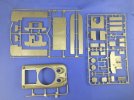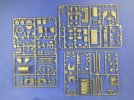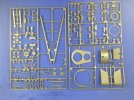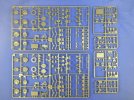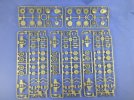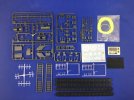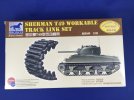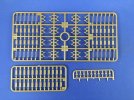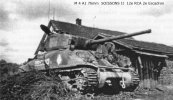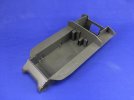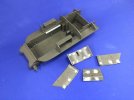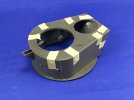- Joined
- Apr 28, 2018
- Messages
- 10,737
- Points
- 113
- First Name
- Jakko
A few weeks ago on this very forum,

As Steve said he was offering it to me because he would like to see it built, I’m going to start on it soon instead of sticking it on the big pile with all the rest of my “to be built sometime” kits
Instructions for it are available on Scalemates, for those who want to see what this kit should be like to build. As it’s a Tasca (now Asuka) Sherman, the basics of it are the same as their other Sherman kits, and thus, accurate and pretty nice to build. All the recovery gear, though, makes it a lot more complex than a tank with a turret.
(As an aside, Italeri also released an M32B1 in the 1980s, but the Tasca/Asuka kit is far more accurate. Most obviously, Italeri used the late-model M4A1 hull with large hatches they already had, when nearly all known M32B1s used early hulls with small hatches. Looking just now at the model I built over 30 years ago, I notice other inaccuracies in stowage, idler wheels and more. It’s certainly not a bad kit, and both cheaper and more easily available than the Tasca/Asuka one, but don’t build it straight from the box if you want an accurate M32B1.)
A quick, potted history of the real thing is that the US Army decided early in the war that it would need recovery vehicles for its tanks, to avoid them becoming losses when the battlefield had to be ceded to the enemy. Because the M3 medium tank (AKA the Lee) was the standard at the time, the M31 recovery vehicle was built, based on that. It had a number of drawbacks, both in the way its recovery equipment was fitted and in that the M4 medium tank (AKA the Sherman) would soon become the standard instead. So, a new recovery vehicle was to be introduced, based on the M4 rather than the M3. Two designs were built as prototypes, the T5 that replaced the turret with a fixed superstructure and added an A-frame pivoted at the front of the vehicle for lifting; and the T7, which mounted the same crane as the M31 used, on the front of the standard Sherman turret (minus its gun). The T5 proved more capable, so it was selected for production, with a few alterations, and was standardised as the M32-series.
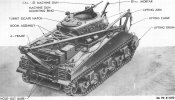
Designs were made for each basic Sherman version, all essentially the same and differing only in the hull. If built on the M4 hull, it was the M32; on an M4A1 hull, it was known as the M32B1; on the M4A2 hull, as the M32B2; and so on. Only the M32B1, -B2 and -B3 were built as more than prototypes, the B2 for the US Marines (because they used the M4A2 extensively and wanted the recovery vehicle to be as compatible as possible), the other two for the US Army. The majority of M32-series vehicles were rebuilt from Shermans that had come in for refurbishing, rather than built new as M32s. Because of a shortage of used M4A1 tanks for conversion, though, a number of M32B1s was built new by converting M4A1s that were still on the production line. (The picture above shows a T5E2 — that is, the prototype based on the M4A2 hull. The visual difference is that T5-series vehicles had three, flat plates in the superstructure front while M32-series vehicles had a single, curved plate there. T5E2s were built in series for the USMC for their first order, so these can be seen in the field in the Pacific; the subsequent order was built as M32B2s.)
In terms of capabilities, all these variants were basically the same. They had a winch of 60,000 lbs (ca. 27 tonnes) capacity centrally in the hull, whose cable could be paid out through a flap in the hull front for pulling directly, through a port in the front of the superstructure to go over the A-frame for lifting, or through an opening in the rear of the superstructure for winching to the rear. Over the A-frame, the maximum load was 30,000 lbs (ca. 13.5 tonnes) when stationary. A variety of tools and tow bars were carried to assist in recovery operations as well as in-the-field repairs. The vehicle was armed with an M2 HB .50-calibre machine gun on an anti-aircraft ring in the roof of the superstructure, an M1919A4 .30-calibre machine gun in a ball mount in the hull front, and an M1 81 mm mortar on the hull front intended for firing smoke bombs, to screen recovery operations from the enemy.
… so I did, and after waiting a while due to customs-related stuff, with thanks to Steve I found myself the somewhat unexpected owner of:—I have an untouched Tasca M32B1 that's available to a be re-homed at a very reasonable price (or swap etc ...). Open to suggestion so if interested please PM me!
As Steve said he was offering it to me because he would like to see it built, I’m going to start on it soon instead of sticking it on the big pile with all the rest of my “to be built sometime” kits

Instructions for it are available on Scalemates, for those who want to see what this kit should be like to build. As it’s a Tasca (now Asuka) Sherman, the basics of it are the same as their other Sherman kits, and thus, accurate and pretty nice to build. All the recovery gear, though, makes it a lot more complex than a tank with a turret.
(As an aside, Italeri also released an M32B1 in the 1980s, but the Tasca/Asuka kit is far more accurate. Most obviously, Italeri used the late-model M4A1 hull with large hatches they already had, when nearly all known M32B1s used early hulls with small hatches. Looking just now at the model I built over 30 years ago, I notice other inaccuracies in stowage, idler wheels and more. It’s certainly not a bad kit, and both cheaper and more easily available than the Tasca/Asuka one, but don’t build it straight from the box if you want an accurate M32B1.)
A quick, potted history of the real thing is that the US Army decided early in the war that it would need recovery vehicles for its tanks, to avoid them becoming losses when the battlefield had to be ceded to the enemy. Because the M3 medium tank (AKA the Lee) was the standard at the time, the M31 recovery vehicle was built, based on that. It had a number of drawbacks, both in the way its recovery equipment was fitted and in that the M4 medium tank (AKA the Sherman) would soon become the standard instead. So, a new recovery vehicle was to be introduced, based on the M4 rather than the M3. Two designs were built as prototypes, the T5 that replaced the turret with a fixed superstructure and added an A-frame pivoted at the front of the vehicle for lifting; and the T7, which mounted the same crane as the M31 used, on the front of the standard Sherman turret (minus its gun). The T5 proved more capable, so it was selected for production, with a few alterations, and was standardised as the M32-series.

Designs were made for each basic Sherman version, all essentially the same and differing only in the hull. If built on the M4 hull, it was the M32; on an M4A1 hull, it was known as the M32B1; on the M4A2 hull, as the M32B2; and so on. Only the M32B1, -B2 and -B3 were built as more than prototypes, the B2 for the US Marines (because they used the M4A2 extensively and wanted the recovery vehicle to be as compatible as possible), the other two for the US Army. The majority of M32-series vehicles were rebuilt from Shermans that had come in for refurbishing, rather than built new as M32s. Because of a shortage of used M4A1 tanks for conversion, though, a number of M32B1s was built new by converting M4A1s that were still on the production line. (The picture above shows a T5E2 — that is, the prototype based on the M4A2 hull. The visual difference is that T5-series vehicles had three, flat plates in the superstructure front while M32-series vehicles had a single, curved plate there. T5E2s were built in series for the USMC for their first order, so these can be seen in the field in the Pacific; the subsequent order was built as M32B2s.)
In terms of capabilities, all these variants were basically the same. They had a winch of 60,000 lbs (ca. 27 tonnes) capacity centrally in the hull, whose cable could be paid out through a flap in the hull front for pulling directly, through a port in the front of the superstructure to go over the A-frame for lifting, or through an opening in the rear of the superstructure for winching to the rear. Over the A-frame, the maximum load was 30,000 lbs (ca. 13.5 tonnes) when stationary. A variety of tools and tow bars were carried to assist in recovery operations as well as in-the-field repairs. The vehicle was armed with an M2 HB .50-calibre machine gun on an anti-aircraft ring in the roof of the superstructure, an M1919A4 .30-calibre machine gun in a ball mount in the hull front, and an M1 81 mm mortar on the hull front intended for firing smoke bombs, to screen recovery operations from the enemy.
Last edited:

